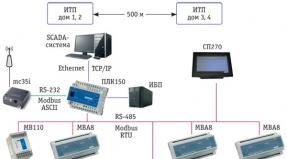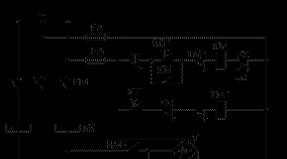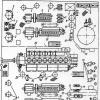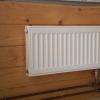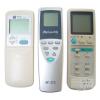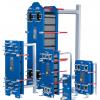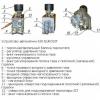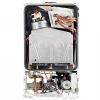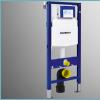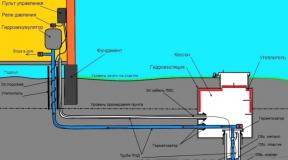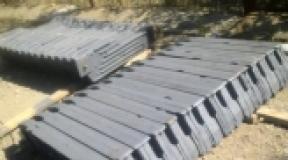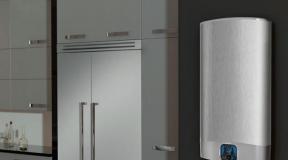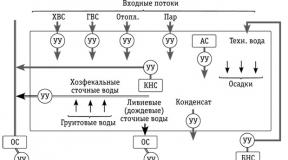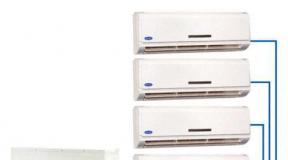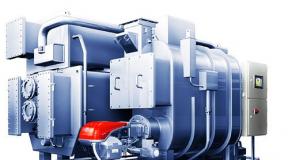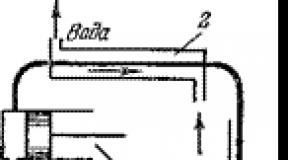Chiller block diagram. Air-cooled chillers: their advantages and varieties. System design
Chiller-fan coil is a universal system that allows you to maintain a comfortable temperature in the room regardless of the season: in summer, cooling the air, and in winter, heating it. Chiller-fan coil unit allows you to maintain comfortable climatic conditions in buildings of any size and number of storeys.
Its principle of operation is similar to that of a hot water heating system. Only instead of a boiler, it uses a universal unit (chiller) designed to cool the liquid, but also capable of heating it.
To maintain a comfortable temperature in individual rooms of the building, the chiller-fan coil system uses fan coil heat exchangers, supplemented by fans.
Any number of indoor fan coil units can be connected to one chiller, usually installed at the top of the building.
Just like heating radiators, fan coil units in one room can be from one to several, depending on the area and requirements for the air temperature.
Water or an aqueous solution of ethylene glycol is used as a heat carrier in chiller-fan coil systems. The distance between the refrigeration unit and fan coil units can be any and is regulated only design features building.
A bit of history
The name of the chiller-fan coil system testifies to its clearly foreign origin: translated from English “chiller” is a powerful refrigeration unit, and “fan coil unit” is a heat exchanger supplemented by a fan.

Meanwhile, chiller-fan coil systems were widely used in the Soviet Union. It was with their help that a comfortable microclimate was maintained in hotels and public buildings. Their installation was envisaged at the design stage along with heating and ventilation systems. The equipment used in chiller-fan coil units and the systems themselves had to comply with the current GOST and SNiP.
Chiller-fan coil systems are versatile and equally efficient for both heating and air conditioning a building. However, the possibility of space heating when using chillers is often overlooked, and the systems themselves are used only in the hot season. The chiller-fan coil unit is compared with a split system and with a central air conditioning system.
But even having omitted the possibility of heating the building, a chiller-fan coil, when compared with a split system, has a number of undeniable advantages.
Chiller-fan coil or split system?
Both of these systems are similar, but a gas refrigerant circulates in the split system, which greatly limits the distance between the chiller and the internal blocks of the system. That is why the outdoor blocks of split systems are placed in close proximity to the indoor blocks, placing them on the facades of buildings.

Due to the use of liquid as a cooling medium, the chiller-fan coil unit has a number of advantages
- Possibility to connect any number of fan coil units to one refrigerator. Of course, their total capacity must correspond to the capacity of the refrigeration unit.
- Compactness: one refrigeration unit is enough to operate the building's air conditioning system, which can be installed in a technical room without damaging the building facade. Fan coil units can be located at any distance from the chiller
- Ease of installation: the air conditioning system is installed in the same way as a heating system using water pipes and valves, which is much simpler and cheaper than gas-filled systems.
- Safety: the level of emergency danger of the system is comparable to that of a conventional water supply. In the event of an accident, there is only a threat of flooding of the premises, the level of which can be reduced with the help of high-quality shut-off valves.
What the chiller-fan coil system consists of
The chiller-fan coil system includes the following structural elements:
- Chiller or central cooling machine
- Fan coil units or local heat exchangers
- Cooling liquid (heat carrier). It can be plain water or ethylene glycol solution.
- A pump called a hydronic module. Large systems usually refer to pumping stations
- Piping
- Automatic control system
How the chiller works

A chiller is a unit designed to cool or heat liquid media used further as heat transfer fluids. Chillers can have a wide range of capacities, thanks to which they are successfully used in the food industry and pharmaceuticals, as well as in climate technology. They are used for air conditioning and heating of public buildings and private houses, for filling skating rinks, cooling drinks and medicines.
The chiller device is similar to that of a household refrigerator. It contains a compressor, condenser and evaporator. The only difference is that thermal energy can be taken in or given off to the liquid circulating through the heat exchanger, for which 2 water circulation circuits are used simultaneously: hot and cold.
In the hot season, the heat of the cooled liquid is used to heat water, which is directed further to the hot water supply. In the cold season, only water is heated.
The movement of hot and cold liquid goes through two separate non-intersecting pipelines through which the coolant flows to the fan coil units.
What are fan coil units - how they work
 Fan coil unit - heat exchanger with fan
Fan coil unit - heat exchanger with fan A fan coil unit is a highly efficient heat exchanger that is simultaneously connected to a cold and hot pipe. To enhance heat transfer, a fan is used, which is mounted behind the fan coil heat exchanger. A feature of the fan coil is the creation of air flows of a given temperature inside the room without additional air flow from the outside, which makes it possible to increase the efficiency of using the thermal energy generated by the chiller.
The fan coil can be controlled in manual or automatic mode.
With manual control, for heating, it is enough to turn off the cold water supply tap to the device, and for cooling, on the contrary, turn off the hot water supply tap, opening the coolant flow.

In automatic mode, it is enough to set the required air temperature in the room on the panel, which is maintained using thermostats that regulate the movement of hot and cold heat carriers.
Fan coil units can be installed in any place: wall, floor, ceiling. If the system is used preferentially for cooling, ceiling mounting is preferred. If, on the contrary, for heating, then fan coil units are placed at the bottom of the walls.
Let's sum up
Chiller-fan coil is an efficient, time-tested, heating and air conditioning system, the use of which ensures a favorable climate all year round.
A chiller-fan coil is equally effective for public buildings and private housing construction, but at present its widespread use is limited by an insufficient number of low-power chillers on the market of our country, the installation of which is possible in individual houses.
Another disadvantage of chillers is the high cost per unit of thermal energy generated with their help. When choosing chillers for heating, they lose to gas boilers.
A chiller is a refrigeration machine designed to cool a refrigerant such as water and glycol solution.
The chiller works thanks to the vapor compression refrigeration cycle, which is also used in simple air conditioners. This means that the chiller contains all four main elements of any refrigeration equipment:
- compressor;
- capacitor;
- evaporator;
- freon flow regulator.
Thanks to a wide range of power and versatility, chillers are used in everyday life, industry (cooling industrial equipment, raw materials, tooling), warehousing, sports (cooling of ice rinks and ice rinks) and public premises (air conditioning) of all sizes.
Chiller working principle:

So, a chiller consists of the following elements: a compressor and a condenser, as well as an evaporator. The main task of the evaporator is to remove heat from the object being cooled. This is why refrigerant and water are passed through the chiller. When the refrigerant boils, it takes energy from the liquid. As a result, water or other coolant is cooled, and the coolant itself is heated and takes on a gaseous state.
The next stage is the transition of the gaseous refrigerant to the compressor, where the hot steam is compressed with heating to a temperature of 80-90 ºС and in the condenser turns into a liquid state.
The principle of operation of the chiller of different types:
Absorption chiller type has the main feature of work - the use of water vapor as a refrigerant, the temperature of which is up to 130 ºС, and is supplied under a pressure of 1 bar. The main advantage of these units is the absence of moving elements, as well as increased operational reliability.
Chillers of a vapor compression type - the most common refrigeration machines that operate on the basis of a compression cycle. The principle of operation of a chiller of this type consists in a continuous cycle of circulation, evaporation, and also condensation of the heat transfer substance.
Air Cooled Chiller mounted outside the structure in the open air. The heat exchanger is cooled with air driven by axial fans. The principle of operation of a chiller with a water-cooled condenser is that an intermediate heat carrier is used to cool the condenser of a refrigerating machine, which is cooled in cooling towers, as well as in dry coolers.
Chiller with remote condenser operates on the basis of a water condenser, is placed inside the room and is connected by a system of freon pipelines with an external installation.
A chiller is a refrigeration machine designed to cool a refrigerant (water, glycol solution, etc.).
The chiller is based on a vapor compression refrigeration cycle similar to that used in conventional air conditioners. That is, a chiller includes all four basic elements of any refrigeration machine: compressor, condenser, evaporator and flow regulator.
Figure 1 shows an outdoor air-cooled chiller. All elements of the refrigeration machine are assembled in a single body, which is mounted on a rigid frame.
We are always ready to help and look forward to your request. Leave your contacts and we will call you back for consultation.
Warm and cold streams
On the opposite side of the chiller there are inlet and outlet water pipes: warm water flows from the building to the chiller, and cold flow returns back. The concepts "warm" and "cold" are rather arbitrary. In fact, during operation of the chiller, both streams are cold: their temperature is about 10 ° C.
However, the temperature of the warm stream is higher. Both temperatures are configurable and can be different, but there are two standard temperature curves: 7/12 and 10/15. In the first case, the temperature of the cold stream is + 7 ° C, and the temperature of the warm stream is + 12 ° C. In the second case, + 10 ° С and + 15 ° С, respectively.
Water cooling
Cooling of water in the chiller is carried out in an evaporator-heat exchanger, in which the working substance of the refrigerating machine (refrigerant or, in short, refrigerant or freon) evaporates due to the heat received from the water. Thus, the water gives up its energy to the refrigerant, due to which it cools. But where does the refrigerant come from?
Refrigerant circuit
Refrigerant circulates inside the chiller. Its movement along the refrigeration circuit is carried out using a compressor, which, in fact, acts as a pump. The refrigerant pumped by the compressor has high pressure (up to 30 atmospheres) and temperature (about 70 ° C).
Then the temperature is released in the condenser: the refrigerant flowing through the pipes is blown by the outside air. At the same time, the refrigerant changes its state of aggregation: it goes from gas to liquid state.
However, the refrigerant pressure remained high. The cooled high-pressure freon passes through the control valve, where it expands. The refrigerant pressure drops sharply.
This process is similar to the delivery of breathing gas for a scuba diver: from a cylinder where the gas is stored under high pressure, it flows to a person who breathes a mixture at normal atmospheric pressure. At the same time, the temperature of the respiratory mixture decreases markedly.
Similarly, the refrigerant after the control valve loses not only pressure but also temperature. Thus, its temperature is reduced to only a few degrees. It can now cool the water flow of the building's cooling system. This takes place in the evaporator. The refrigerant then flows back into the compressor and the cycle closes.
Heat sink
Thus, a special working substance circulates in the chiller - a refrigerant. Its purpose is to cool water and energy obtained from water and transfer it to the environment. Both energy transfer processes are implemented in heat exchangers (heat exchangers).
As we already know, water is cooled in the evaporator: here the refrigerant receives the thermal energy of the water. Heat is released into the environment in the second heat exchanger - in the condenser.
The condenser is the only place where the refrigerant comes into contact with the environment: the pipes through which the refrigerant flows are blown with outside air. At the same time, the hot refrigerant cools down, that is, it gives up its energy, and the outside air heats up.
This can be easily verified by moving your hand over the top of the chiller or even just walking up to the outdoor unit of a conventional air conditioner. The temperature of the air blowing from there is noticeably higher than the ambient temperature.
So, the heat that is emitted by people, equipment, lighting, as well as the heat entering the premises due to solar radiation, is transferred to the water circulating through the pipes. In the evaporator of the chiller, the water transfers this heat to the refrigerant. And in the condenser of the refrigerating machine, the same heat goes out.
The compressor is the heart of the refrigeration machine
The compressor is the heart of the chiller. For example, Hitachi chillers of the Samurai series use the latest screw compressors (see Figure 2). Compressors are the most energy-consuming elements of a chiller, therefore optimization of their energy consumption is one of the main tasks.
Figure 2. Layout of a twin screw compressor in Hitachi chillers of the Samurai series:
1. Highly reliable two-pole HITACHI electric motor
2. Built-in oil separator (cyclone type oil separator)
3. Sight glass for oil level control
4. Oil heater
5. High precision twin screw rotors
6. Filter in the suction section
Few moving parts make the compressor highly reliable, low noise and low vibration. In addition, these compressors use continuous capacity control technology to perfectly adapt to the load by precisely controlling the chilled water temperature and eliminating the need for expensive inverters.
Discharge of heat outside
 Figure 3. Condenser fans in Hitachi chillers
Figure 3. Condenser fans in Hitachi chillers
Heat is removed to the environment in a condenser - a heat exchanger through which coolant and outside air move. In this case, the movement of the refrigerant, as we already know, is provided by the compressor.
The air movement is carried out by the condenser fan. In the general view of the chiller (see Fig. 1) 6 cylindrical elements are visible from above - it is in them that the fans are installed, ensuring the movement of air through the condenser. The air is sucked in from the sides of the chiller, passes through the condensers, heats up, and then is thrown out vertically upwards.
Condenser fans are the second largest energy consumer in chillers, and therefore a lot of attention is paid to their design and profiling.
In particular, Hitachi uses new two-blade fans (see Fig. 3), which reduce noise compared to a four-blade propeller. This increases the static head of the air flow and, at the same time, significantly reduces the power consumed by the electric motor.
Work "warm"
Many chillers can also operate in a reverse refrigeration cycle, generating heat instead of cold. This is akin to the reverse mode of operation of air conditioners - the mode of operation "for heat". In this case, the condenser of the chiller plays the role of an evaporator and takes heat from the environment, and in the evaporator (which has now become a condenser) heat is transferred to the refrigerant. By the way, in this case, it is more appropriate to call the coolant a coolant.
Chillers are gaining in popularity. Today they can be seen in various fields: pharmaceuticals, health and sports, food industry, shopping centers, residential buildings and apartments, offices and many other establishments. Chillers are installed indoors different sizes... All thanks to the solid power range. What is the reason for the demand for this equipment? What is a chiller, what is its structure and how does it work?
Important equipment features
The refrigeration unit, which is designed to heat and cool heat transfer fluids in the main air conditioning system, is called a chiller. Heat carriers can be fan coil units or supply-type mechanisms.
The service life of a chiller is largely dependent on technical characteristics products. It is also of great importance whether the rules for the operation of this equipment are followed.
The main features of the chiller include the following.
- This system is flexible. In it, the distance between the fan coil units and the chiller is limited only by the pump power and can be hundreds of meters.
- Thanks to this equipment, you will be able to save money.
- The equipment can be used at any time of the year.
- It is possible to automatically maintain the set parameters in each room.
- By using shut-off valves, the risk of flooding is minimized.
- The equipment makes almost no noise during operation.
- The refrigerant is safe and environmentally friendly.
- Construction pluses - flexibility of planning, small expenses of usable area for equipment placement.
The choice of a chiller should be approached with all responsibility. In order not to be mistaken, it is important to know what types of chillers exist, as well as what the device and basic principles of operation of such installations are.
The chiller device is somewhat different from the device of a conventional refrigerator or air conditioning system. The chiller does not lower the air temperature. It lowers the temperature of the substances used to move cold. This equipment can cool, for example, glycol solution or water. Then the liquid goes where cold is needed.
The chiller has the following functional elements:
- air condenser;
- storage capacity;
- high and low pressure switches;
- compressor mechanism;
- plate heat exchanger;
- pressure gauges for liquid;
- filter drier;
- thermostatic valve;
- flow switch;
- pump;
- receiver.
The exact set of components depends on the hardware modification.
What is the principle of the chiller?

Hitachi centrifugal chiller operation diagram
The operating principle of the chiller has its own characteristics. If you need this equipment, then you should certainly familiarize yourself with it. The chiller is based on an almost non-stop cycle. Much depends on the consumer.
For example, freon moves through the air conditioning system. The gas flows through the radiator of the indoor unit, which is cooled. Air blows over the radiator. As a result, freon warms up, and the air temperature drops. Freon enters the compressor. In the chiller, the role of freon is played by cold water that flows through the radiator. The radiator is blown with warm air from the room. The water heats up and the air cools down. Water flows back into the chiller.
The heat exchanger for the chiller has two circuits:
- fluid circulates through one of the circuits;
- freon moves along the other circuit.
These two contours touch each other. However, water and freon do not mix. In order to improve the efficiency of the system, these environments move towards each other.
Such processes take place in the heat exchanger.
- Through the thermostatic valve, liquid freon enters its own circuit of the heat exchanger. This substance expands, which leads to the removal of heat from the walls. Because of this, freon heats up and the walls cool.
- Water flows along the heat exchanger circuit. Due to the fact that the walls are cooled, the temperature of the liquid drops.
- Freon enters the compressor, and cold water cools something.
- The cycle repeats.
Chiller varieties
On sale presented different kinds chillers:
- absorption - energy is obtained mainly from waste heat that arises in the production process and is simply emitted into the environment (this is, for example, hot water cooled by air);
- vapor compression - cold is generated in a vapor compression cycle, which consists of such procedures as evaporation, throttling, etc.
By the way of installation, chillers are divided into:
- outdoor - a single monoblock that is mounted on the street;
- internal - equipment, which consists of two parts. The condenser is installed outside the building, all other parts inside.
According to the type of condenser, chillers are divided into the following subspecies:
- with cooling water type. A system with such cooling is relatively expensive, but it is more reliable;
- air-cooled. The simplest and most inexpensive option.
Chillers are divided into the following types according to the type of hydronic module:
- with built-in installation. Equipment with this hydronic module is a monoblock, which includes an expansion tank and a pumping group;
- with remote installation. Such a hydronic module is usually used in cases where the power of the built-in mechanism is insufficient. It is also used in cases where there is a need for redundancy.
The chiller can be equipped with one of the following types of compressors:
- screw;
- rotary;
- piston;
- spiral.
Chillers are also classified according to the type of fan. The equipment can be equipped with the following fans:
- axial. Equipment with such a fan can be installed exclusively outside the building. It is imperative that there are no obstacles to the entry of air into the condenser and to its discharge by the fans;
- centrifugal. Equipment with such a fan is recommended for indoor installation. It is distinguished by its small dimensions and low noise level.
Important aspects of chiller installation
In order to experience all the advantages of operating a device such as a chiller installation, its installation must be carried out strictly in compliance with certain rules. Here are the main ones.
- This equipment should only be installed by competent technicians.
- The chiller must fully meet the design criteria for the utility network in terms of installation site, design and capacity.
- It is forbidden to install equipment that is defective.
- The equipment can only be moved to the place where it will be installed using a crane.
- It is allowed to fill only water, as well as a solution of ethylene or propylene glycol, which has a concentration of up to 50 percent.
- The commissioning tests must be carried out without fail.
- There must be a space around the chiller to allow unhindered access for a service technician.
- Strictly observe safety precautions and manufacturer's recommendations.
By purchasing and installing a chiller, you can be sure that you will get a modern and reliable system.
Chillers are gaining increasing popularity in various spheres of human activity. They are widespread not only in industrial areas, but also as household home or office equipment.
Consider the principle of the chiller, what it is and how this unit is designed.
Chiller Applications
First, let's figure out what a chiller is.
A chiller is a powerful unit designed to cool a liquid used as a heat carrier in central air conditioning systems, such as air handling units, fan coil units. It is needed for the circulation of liquid substances, for example, water, antifreeze.
The main parameter of the chiller is power, or cooling capacity. In the market of climatic equipment, all devices have a capacity of 5 to 9 thousand kW. Depending on this parameter, as well as the installed equipment and the area of \u200b\u200bthe premises, chillers find their scope.
So, for centralized air conditioning in apartments, houses, offices and other institutions, low-power systems are used. A unit with a high heat absorption capacity is used in the metalworking industry, mechanical engineering, and medicine. 
Chillers are also required to perform these tasks:
- cooling of alcoholic beverages, juices, syrups during production;
- lowering the temperature of drinking and process water in food processing equipment;
- maintaining the temperature regime in the pools;
- formation of ice skating rinks on sports grounds;
- cooling of special medical facilities;
- release of medicines at low temperatures;
- cooling of laser machines;
- production of plastic and rubber products;
- equipment for the chemical industry.
Types of Chillers
On sale are such types of chillers as:
- Absorption. In the production process, water or absorbent is used instead of freon.
- Vapor compression. Cooling results from a vapor compression cycle consisting of evaporation or throttling.
By the method of installation, refrigeration machines are divided into the following types:
- Outdoor. Set in the form of a monoblock on the street.
- Internal The equipment consists of two parts. The condenser is mounted outside the building, the rest of the parts inside the building.

By type of condenser, chillers are:
According to the type of hydronic module design, cooling units are divided into the following types:
- with integrated installation;
- with remote installation.
By the type of compressor, chillers can be:
- screw;
- rotary;
- piston;
- spiral.
The types of refrigeration equipment also depend on the type of fans. Chillers are equipped with the following fans:
- axial;
- centrifugal.
The classification of units is shown in the photo.

Chiller unit
We will analyze how this climate technology works and what it consists of.
Vapor compression chiller
The design of the vapor compression refrigeration unit may vary depending on the modification and type of the chiller, but the main elements of the system are:
- evaporator;
- capacitor;
- compressor.

The principle of operation of a vapor compression chiller is as follows.
- When the compressor compresses the vapors of the working substance, or refrigerant, the pressure reaches 30 atm, the temperature rises to 70 ° C. The condensation process begins.
- The condenser gives off heat to the outside. The condenser is the only mechanism in which the refrigerant comes into contact with the air. Outside air blows through the mixture, which changes the state of aggregation and turns into a liquid. At the same time, the hot freon cools down and gives up its energy, the air heats up.
- Then the working medium passes through the control valve and expands. The pressure drops. The temperature drops sharply. Freon boils and, having passed through the evaporator of the chiller, goes into a gaseous state, absorbs the energy of the coolant and cools it. Then the substance again enters the compressor. The cycle is repeated.
The chiller circuit and its device are based on this principle. Many units operate in the reverse refrigeration cycle - they generate heat instead of cooling.
It is better to show how the chiller works on a schematic diagram or in the form of a drawing of the cooling equipment. 
Absorption chiller
The principle of operation of the absorption chiller is shown in the diagram.

Advantages and disadvantages of chillers
The refrigeration system has several advantages:
- Convenience of operation.
- The ability to place the unit at a distance from the refrigerated space.
- Partial replacement of heating systems, reducing the number of batteries.
- Reduced operating costs.
- Environmental friendliness.
- Minimization of usable area.
- Silent work.
- Safety.

Disadvantages of chillers:
- Large dimensions of indoor units.
- Great weight.
- Complex installation, installation depends on the modification of the units.
- Increased power consumption.
- High price.
When choosing a chiller, you should pay attention to all these indicators. If there are few rooms in the room and there are no large rooms, you can buy other climatic equipment, smaller and more efficient.

